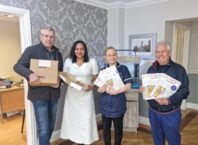23-year-old Bethany Turner from Harlow in Essex has suffered her whole life, but it was only when she reached 17 that she was diagnosed with a rare, deadly and currently incurable disease.
Yet Debbie Crowson, Bethany’s mother, says she is being failed by the care system and is having to fight for the support and care she needs. Bethany suffers from TUBB4A leukodystrophy, a rare and deadly disease that makes up 9% of a group of about 30 rare neurodegenerative disorders typically diagnosed in toddlers and young children.
Despite social workers suggesting that Bethany should be ‘put into an institution’, her family want to care for her at home where she is happy, yet they are struggling to do so without more support and a better-equipped house.
The struggle to care for her daughter has also taken its toll on Debbie. She said, “I’ve been told I should be selfish, I should look after myself first. But how can I?”
Debbie has been on anti-depressants and has faced some dark times; thinking back through everything that’s happened, she said; “If I’d known this when Bethany was very young I don’t know what I’d have done.”
However there is cause for optimism as Oxford biotech firm SynaptixBio is hoping to take a lifechanging new treatment into clinical trials next year.
The treatment couldn’t come soon enough for the family as Bethany’s eating and drinking have deteriorated; she can’t eat certain foods and her face muscles tire easily. She is now unable to walk but can crawl around at home.
Debbie says she and Bethany need to move house but can’t do so easily; “We have a downstairs bedroom and wet room but it’s not safe to leave Bethany there at night. The bed in my room isn’t safe. We really need a bungalow.”
Bethany is now officially out of the system; she gets social care three days a week, but Debbie says she is entitled to five. She gets 40 days overnight respite care per year, but that’s in Basildon, almost 30 miles away; there is nothing local to Harlow. Bethany has to be taken to her local day centre to be picked up and returned from an overnight stay.
But Debbie’s struggles started when Bethany was very young.
After a normal labour and birth, at six weeks Debbie noticed that Bethany’s head and body were floppy; at eight months, Bethany was still not sitting up and her fine motor skills were not developing.
When Bethany was around one year old, she had blood tests and her health visitor referred her for physiotherapy. By now, Bethany could crawl and climb on furniture
At two and a half, Bethany was referred to the Child Development Centre in Harlow. They thought Bethany had cerebral palsy; she was often curled-up, appeared to be double-jointed and had hypermobility. Debbie said, “It looked like she was trying to run, but of course she couldn’t. She would often fall flat on her face. It was very distressing.”
One year later, aged three and a half, Bethany had an MRI scan, which wasn’t successful, at the local hospital to formally check for cerebral palsy; at this stage she was sleeping poorly, and was wakened easily by any noise.
Another year on and Bethany is at Addenbrookes in Cambridge for more tests, including mitochondrial DNA and another MRI scan, which this time was successful. When the results arrived three months later Debbie was told that Bethany’s was not typical cerebral palsy, and that from her MRI scan the white matter in her brain was inflamed. However, overall, the blood tests were inconclusive.
Bethany’s MRI scan results were sent to the Amsterdam Leukodystrophy Centre in the Netherlands, which suggested she may have CMV (cytomegalovirus) – a usually harmless virus that can have more serious impacts on those with weakened immune systems. However, a cord blood test came back negative. Bethany was discharged from Addenbrookes as they concluded there was nothing progressive about her condition.
Until Bethany was 12, very little changed. Bethany fell over a lot, but she attended mainstream school. She could recognise the shapes of words though her speech development was delayed. She had behavioural issues and attended physiotherapy and occupational therapy.
It was then things began to deteriorate; she left Primary School (after a year’s delay) and from 12 to 19 attended Harlow Fields School, a special needs school and college.
At 16, Bethany’s walking was quite poor; she needed a wheelchair most of the time. However, the physiotherapist who had helped Bethany when she was very young started to see her again; she was convinced there was more to Bethany’s symptoms and eventually got her referred to Great Ormond Street Hospital (GOSH).
This was the first time since she was four that her condition and motor difficulties were being properly investigated.
By late 2016, progress had been made in identifying the underlying causes of certain leukodystrophies, so when Bethany’s latest MRI scan results and bloods, for gene sequencing, were again sent to the Amsterdam centre the results this time were more definitive; Debbie was told that Bethany had Hypomyelination with Atrophy of the Basal Ganglia and Cerebellum (H-ABC), a severe form of TUBB4A related leukodystrophy.
It affects more than 2,000 children born worldwide each year.
Debbie was understandably devastated; she became quite depressed, for which she took medication, and struggled to cope. “No-one seemed to know anything about it, and I had no confidence in the system. It was frightening.”
The disease, which mainly affects babies and children, is rare but deadly and currently incurable. Survival is often limited to the stage of young adulthood.
She added; “We don’t know how it will progress, but I won’t give up.”
Bethany was almost 17 when her diagnosis was finally made. Both Debbie and Bethany’s father were also tested and are clear; the disease is the result of a random mutation.
First discovered in 2015, TUBB4A leukodystrophy is caused by a mutation in the TUBB4A gene, which leads to impaired myelin production. This causes disruption to the signals traveling between nerve cells in the brain.
Currently, there is no cure.
According to the University of Utah, leukodystrophies affect 1 in 7,663 births. This means about 20,000 people could develop a leukodystrophy – including more than 2,200 with TUBB4A – each year.
When Bethany turned 18 she could no longer be treated at GOSH; after finishing school at 19, she attended Hertford Regional College in Ware, where she stayed until aged 22.
In the last few years her eating and drinking have deteriorated; she can’t eat certain foods and her face muscles tire easily. She is now unable to walk but can crawl around at home.
Debbie says her and Bethany need to move house but can’t do so easily; “We really need a downstairs bedroom and wet room. The bed in my room isn’t safe.”
Bethany, at 23, is now officially out of the system; she gets social care three days a week, but Debbie says she is entitled to five. She gets 40 days overnight respite care per year, but that’s in Basildon; there is nothing local to Harlow. Bethany has to be taken to her local day centre to be picked up and returned from an overnight stay.
Meanwhile, UK biotech firm SynaptixBio is aiming to develop the world’s first treatment for TUBB4A leukodystrophy, and recently secured £13.2m in funding to progress research and hopefully take a treatment into clinical trials next year.
The Oxford-based company has teamed up with a world-leading leukodystrophy hospital in the US, the Children’s Hospital of Philadelphia – CHOP, to develop a drug from antisense oligonucleotides (ASOs), which can prevent or alter the production of proteins.
It is hoped ASOs, which have previously been used to treat conditions such as Duchenne muscular dystrophy and spinal muscular atrophy, will dramatically improve the quality of, and extend, the lives of TUBB4A patients.
The project has also secured two prestigious designations from the Food and Drug Administration (FDA) in the US to develop the treatment.
SynaptixBio CEO Dr Dan Williams said the treatment had the potential to “adapt the disease mechanisms, redress motor skills deficiencies and boost survival rates.”
Dr Williams added; “TUBB4A leukodystrophy has only recently been identified, so it’s not surprising that general knowledge isn’t widespread within the NHS, but the concern remains that undiagnosed children may suffer more than is necessary.”
Here, The H-ABC Foundation raises awareness of the disease and funds research. Debbie found the group and other affected families through Facebook and WhatsApp, and occasionally uses them to stay up to date with developments.




